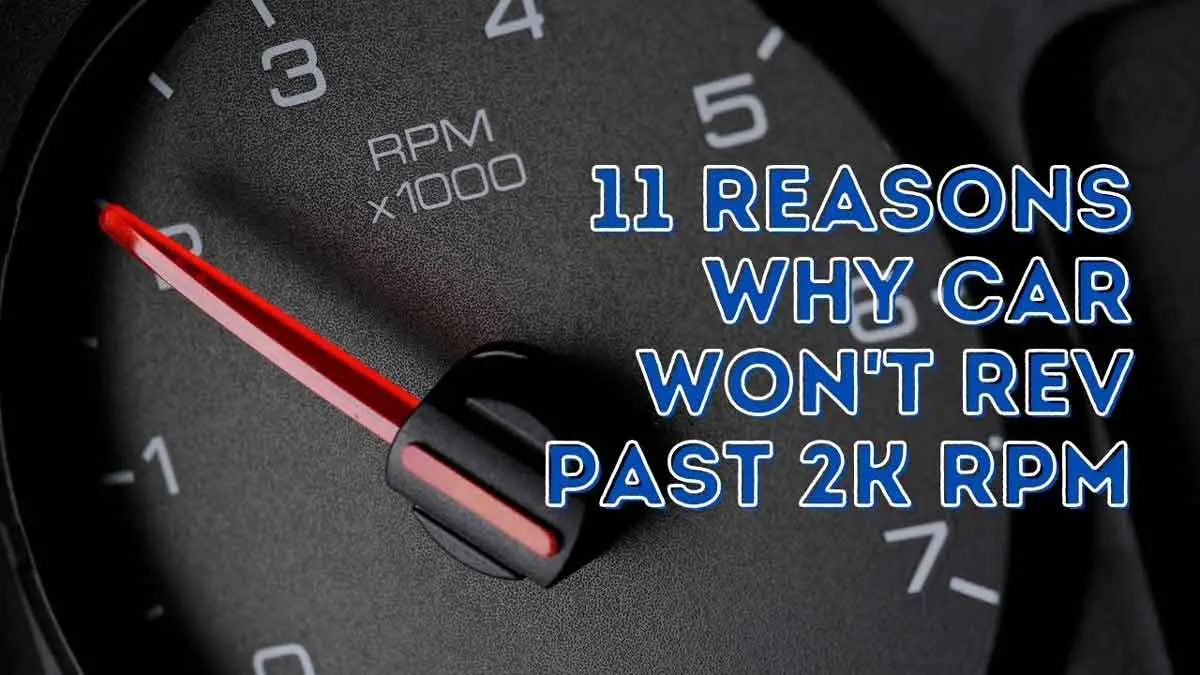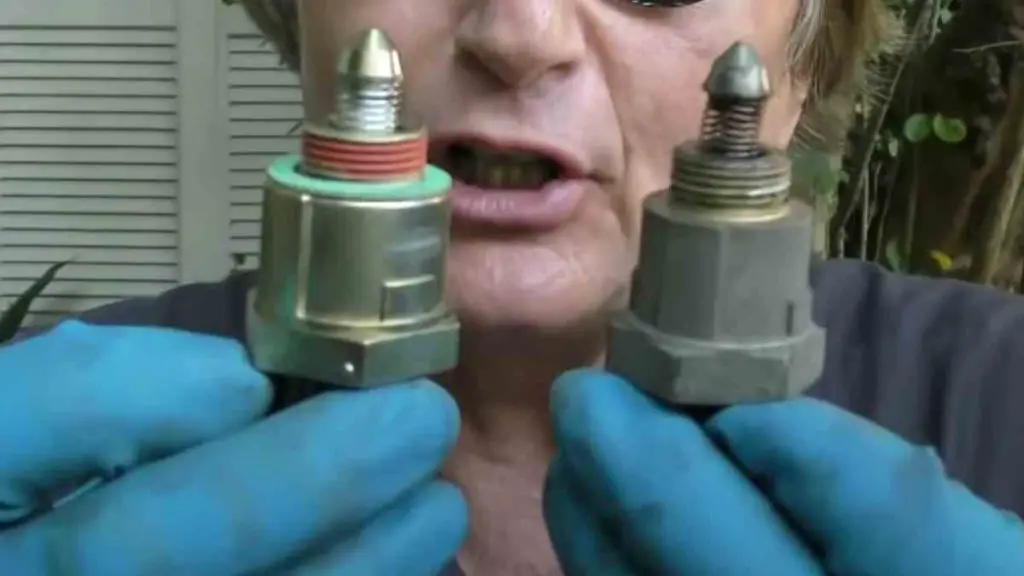Why My Car Can't Go Over 2000 RPM? The most common reasons are clogged catalytic converters, activated limp mode, clogged air filters, clogged fuel filters, bad oxygen sensors, and restricted exhaust. Apart from these, there are many other reasons which we've discussed below.
Driving is fun when your vehicle responds to you. That means it will work exactly what you want it to do.

But there are many times when you may experience that your car is losing power when it reaches 3000 RPM or maybe 2000.
Either way, this is a problem that needs a fast solution to minimize damage to your car components.
In this article, we will share with you 11 reasons that may restrict you in an engine RPM within the 3000 range so that you can quickly figure out what to do next! Keep reading!
1. Idle Air Control Module Malfunction
One of the most common reasons for unstable engine RPM is a bad or malfunctioning Idle air control valve.

While its work process is complicated, it is quite easy to fix. It is either bad or dust and debris preventing it from functioning properly.
So, the first step is to open it up and clean it. Check if any carbon is built up. If yes, spray a cleaner and eliminate any unwanted materials from it. And reinstall this in your car to check whether the problem persists.
If the problem is gone, log in to your Paypal and send me tips [LOL]. And if it persists, replace it with a new one.
Since the process is simple yet not great to explain without any visuals, I recommend watching this video from Scotty Kilmer to replace or clean the Idle Air Control Valve-
2. Clogged Catalytic Converter
If your vehicle is old and you have not changed the cat yet, check it out. It may have clogged, causing your engine RPM to go down after going up to 2000 or 3000 RPM.
We have a detailed guide on the clogged catalytic converter and how to deal with it. Check that out for detailed guidelines.
3. Car in Limp Mode
This is the most common cause in newer cars that experience the engine RPM problem. This is a precautionary function in modern cars that reduces the performance of your vehicle to prevent further damage to it.
This activates when it gets any fault signal from the vehicle computer system. If it activates, then nothing to worry about. Reach your home safely and check what caused the limp mode to activate.
In most cases, you can fix the issue by changing the oil, cleaning filters. And we have some reported cases where it appeared suddenly and disappeared after going home and turning the engine off.
4. Clogged Air Filter
A clogged air filter can create the problem as well. As it lets air into the system to maintain balance, any clog or malfunction in the filter will affect your engine RPM.
It may cause the engine RPM to go very high or very low. So, check if the air filter is clogged or damaged. Either way, a replacement is recommended.
If you want to clean the air filter, you may use this air filter cleaner-

5. Clogged Fuel Filters
This happens mostly when people replace a fuel filter but the new one doesn’t fit well. Plus, a clogged fuel filter will cause the same problem as well.
If this is the cause, you need to change the old fuel filter and get a new one for your vehicle that fits perfectly.
When installing the new one, make sure to follow the best practices for getting the optimal result-
- Locate the fuel filter in your vehicle to think about the correct course of action.
- Take a few drops of oil on your fingertips and lubricate the new o-ring.
- Now, place the o-ring carefully in the correct groove specified by the manufacturer.
- Fill half of the fuel filter with oil so that the engine doesn’t run dry when you start after replacement.
- Hand tighten the new fuel filter in its place before using a wrench to make it snug. Avoid overtightening the oil filter.
- After replacement, start the vehicle and check if there are any leaks around the filter.
6. Clogged Mass Air Flow Sensor
A bad or clogged mass airflow sensor can cause problems like engine stall, low RPM, hesitation, jerking, and hiccups.
In most cases, a thorough clean-up of the sensor will do the job for you. Remove the sensor, clean it, let it dry, and reinstall it in its position is the process you need to follow.
Watch this video from ChrisFix to perform the cleanup-
7. Bad Oxygen Sensor
A bad oxygen sensor can show symptoms similar to the clogged catalytic. The easiest way to check if the problem is caused by the O2 sensor is to unplug the sensor from the exhaust pipe and run the engine.
If the problem disappears after the removal of the o2 sensor, replace the bad one ASAP.
Your owner’s manual will have information about the location of the o2 sensor. And the replacement process is pretty straightforward for almost all vehicles-
- Buy a compatible o2 sensor.
- Disconnect the wire of the o2 sensor and remove the sensor from the system.
- Put the new sensor in place and connect it with the electrical system.
- You’re done!
In some cars, you may need an oxygen sensor socket to remove the old one and install the new sensor. For those situations, I recommend getting this socket set-

8. Bad Throttle Position Sensor
Another common cause of weak engine acceleration or low engine RPM is having a bad throttle position sensor installed in your car.
Apart from causing engine RPM won’t go over 2000 RPM problem, it can cause problems like sudden engine idle, sudden stall, drop in fuel efficiency, etc.
Watch this to solve the issue-
9. Camshaft Position Sensor Malfunction
The most common symptom of a bad camshaft position sensor is weak acceleration. You will feel that the engine RPM is not going to the position where it should be when you press the accelerator pedal.
While it doesn’t immediately show up any major symptoms, it can ruin your engine pretty quickly. So, scan the vehicle to find out the real problem causing the issue for you.
10. Serpentine Belt
The serpentine belt, popularly known as the drive belt, can also cause the issue. A slight deviation from its original position can adversely affect the engine’s RPM and acceleration.
So, don’t forget to check the belt too, for any issues. And if you have an old or damaged belt, you should replace it to get your desired performance out of the vehicle.
11. Check Engine Light
Last but not least one to check is your check engine light. As you know that the check engine light can turn on for various reasons. It can turn on for very silly 1-minute fix issues into engine damage problems. So, you shouldn’t panic if it lights up.
Whether the light is on or not, the first thing we recommend doing is to scan the car computer system for fault codes with an OBD 2 scanner.
This will give you a quick and easy way to find the location of the problem and the way to fix it.
Car Stopped Accelerating While Driving and Now Won’t Start
While this is a rare problem, this happens to some cars mainly because of two problems.
Either you have a bad fuel pump or a bad timing chain, aka cambelt or timing belt. You should scan these two components for any damage. Replace them with new products if you find them damaged.
However, the problem may have been caused by other problems as well.
So, scheduling an engine no-start inspection is a must if the problem doesn’t go away after replacing the failed fuel pump or timing belt.
Final Words
As you end up reading all 11 reasons that can affect engine RPM to be restricted under 2000 or 3000, you should now be able to figure out what causing the problem and how to fix it.
However, we have not covered any specific solutions for some of the problems as they can vary from vehicle to vehicle and the problem may cause by other problems as well in your car.
Or you may have been driving incorrectly. Either way, we recommend you start with the OBD scan tool to figure out the problem.
If you don’t find any fault codes there, you should check the components one by one as we have listed in this article.
Whether it is not accelerating past 2500 rpm, doesn’t rev past 4000 RPM, or any other weak acceleration problems, you can use this checklist of 11 causes to figure things out initially.